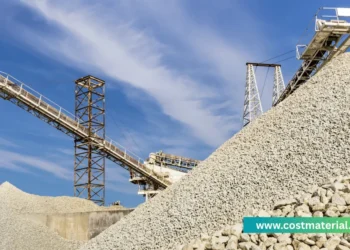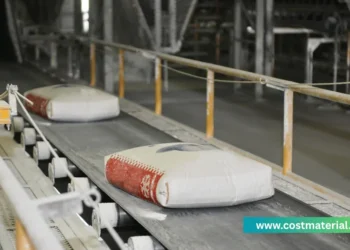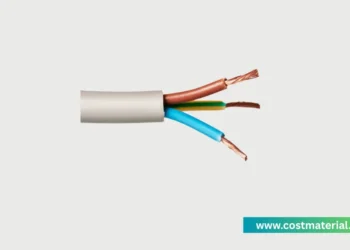Table of Contents
Planning a construction project in the Philippines requires careful budgeting. Material costs, in particular, can significantly impact your overall expenses. Consequently, having an up-to-date GI sheet price list is essential for accurate financial planning. This comprehensive guide provides detailed information on galvanized iron (GI) sheet prices. Furthermore, it explores the various types of GI sheets available. We will also delve into the factors that influence their cost. This will empower you to make informed decisions for your roofing, walling, or other construction needs.
1 Understanding Galvanized Iron (GI) Sheets
Before we dive into the numbers, it’s crucial to understand what GI sheets are. Galvanized iron sheets are steel sheets coated with a protective layer of zinc. This process, known as galvanization, is incredibly important. It shields the steel from rust and corrosion. Therefore, it significantly extends the material’s lifespan. In the Philippines, a country with a tropical climate and high humidity, GI sheets are a popular choice. They offer a perfect blend of durability, affordability, and resilience against the elements.
The galvanization process typically involves hot-dipping the steel sheets in molten zinc. This creates a strong, bonded coating. As a result, the final product is highly resistant to weathering and physical damage. This makes GI sheets a reliable material for a wide range of applications.
2 Types of GI Sheets and Their Applications
GI sheets are not a one-size-fits-all solution. They come in various forms, each suited for specific purposes. Understanding these differences is key to selecting the right material for your project and accurately interpreting the GI sheet price list.
Corrugated GI Sheets
Corrugated GI sheets are easily recognizable by their wavy or ribbed pattern. This design is not just for aesthetics; the corrugations significantly increase the sheet’s strength and durability. This allows it to span wider areas without sagging. Consequently, corrugated GI sheets are the go-to material for roofing in the Philippines. They are used in everything from residential homes to large industrial warehouses. Additionally, their design facilitates efficient water runoff, which is crucial during the rainy season.
Plain GI Sheets
As the name suggests, plain GI sheets are flat and smooth. While they lack the structural rigidity of their corrugated counterparts, they offer immense versatility. Plain GI sheets are frequently used for walling, cladding, and fabricating various items. For instance, they are used to make water tanks, ductwork for ventilation systems, and other custom metal works. Their smooth surface also makes them ideal for applications where a flat finish is desired.
Pre-painted GI Sheets (Coloroof)
For those who want to combine durability with aesthetics, pre-painted GI sheets are an excellent option. These sheets are galvanized and then coated with a layer of high-quality paint. This provides an additional layer of protection against the elements. Moreover, it eliminates the need for on-site painting, which saves time and labor costs. Pre-painted GI sheets come in a wide array of colors. This allows architects and homeowners to achieve their desired look. They are commonly used for high-end roofing, sidings, and decorative panels.
3 Key Factors That Influence the GI Sheet Price List
The price of GI sheets is not static. It fluctuates based on a variety of factors. Being aware of these can help you understand price differences and potentially find better deals.
Thickness (Gauge)
One of the most significant factors affecting the price is the thickness of the sheet, which is measured in gauge. It is important to remember that the gauge system works in reverse. A lower gauge number indicates a thicker and more durable sheet. For example, a gauge 24 (0.6mm) sheet is thicker and more expensive than a gauge 26 (0.5mm) sheet. Thicker sheets offer greater strength and longevity, making them a worthwhile investment for critical applications like roofing.
Size and Length
GI sheets come in standard widths and lengths. The most common lengths are 8 feet, 10 feet, and 12 feet. Longer sheets will naturally cost more. In addition to standard sizes, many suppliers in the Philippines offer long-span GI sheets. These are custom-cut to the required length of the roof, which minimizes overlaps and potential leak points. While the per-meter cost might be slightly higher, the long-term benefits often outweigh the initial expense.
Brand and Manufacturer
The reputation of the brand or manufacturer also plays a role in pricing. Established brands with a long history of producing high-quality GI sheets may command a premium. These companies often have stricter quality control measures in place. This ensures that their products meet national and international standards. While it may be tempting to opt for cheaper, unbranded alternatives, investing in a reputable brand can provide peace of mind and better long-term performance.
Supplier and Location
Prices can also vary depending on the supplier and your location in the Philippines. Large hardware depots in major cities like Manila, Cebu, or Davao may offer more competitive pricing due to higher sales volumes. Conversely, smaller, provincial hardware stores might have slightly higher prices to account for their own transportation and logistics costs. Therefore, it is always a good idea to get quotes from multiple suppliers in your area.
Global Steel and Zinc Prices
Local prices are also influenced by the global market for steel and zinc, the primary raw materials for GI sheets. Fluctuations in supply and demand on an international level can have a trickle-down effect on the prices you see at your local hardware store. Trade policies and currency exchange rates can also impact the final cost of imported raw materials.
4 The Ultimate GI Sheet Price List Philippines (2025 Estimates)
Here is a detailed, estimated GI sheet price list for the Philippines. Please note that these are approximate values and can vary based on the factors mentioned above. It is always best to contact your local suppliers for the most current and accurate pricing.
Corrugated GI Sheet Price List
| Thickness (Gauge) | Standard Length | Estimated Price Range (PHP) |
|---|---|---|
| Gauge 26 (~0.4mm) | 8 ft | ₱ 380 – ₱ 450 |
| Gauge 26 (~0.4mm) | 10 ft | ₱ 475 – ₱ 560 |
| Gauge 26 (~0.4mm) | 12 ft | ₱ 570 – ₱ 670 |
| Gauge 24 (~0.5mm) | 8 ft | ₱ 480 – ₱ 580 |
| Gauge 24 (~0.5mm) | 10 ft | ₱ 600 – ₱ 720 |
| Gauge 24 (~0.5mm) | 12 ft | ₱ 720 – ₱ 860 |
| Gauge 22 (~0.7mm) | 8 ft | ₱ 650 – ₱ 780 |
| Gauge 22 (~0.7mm) | 10 ft | ₱ 810 – ₱ 970 |
| Gauge 22 (~0.7mm) | 12 ft | ₱ 970 – ₱ 1,160 |
Plain GI Sheet Price List
| Thickness (Gauge) | Standard Size | Estimated Price Range (PHP) |
|---|---|---|
| Gauge 26 (~0.4mm) | 4 ft x 8 ft | ₱ 550 – ₱ 680 |
| Gauge 24 (~0.5mm) | 4 ft x 8 ft | ₱ 700 – ₱ 850 |
| Gauge 22 (~0.7mm) | 4 ft x 8 ft | ₱ 900 – ₱ 1,100 |
| Gauge 20 (~0.9mm) | 4 ft x 8 ft | ₱ 1,200 – ₱ 1,450 |
| Gauge 18 (~1.2mm) | 4 ft x 8 ft | ₱ 1,600 – ₱ 1,900 |
| Gauge 16 (~1.5mm) | 4 ft x 8 ft | ₱ 2,000 – ₱ 2,400 |
Pre-painted (Coloroof) & Long-Span GI Sheet Price List
Prices for pre-painted and long-span sheets are often quoted per meter and can vary significantly based on the color, profile (rib-type, etc.), and brand.
| Type | Thickness (mm) | Estimated Price Range (PHP per meter) |
|---|---|---|
| Rib-Type | 0.40mm | ₱ 250 – ₱ 320 |
| Rib-Type | 0.50mm | ₱ 330 – ₱ 410 |
| Rib-Type | 0.60mm | ₱ 420 – ₱ 500 |
| Corrugated | 0.40mm | ₱ 240 – ₱ 300 |
| Corrugated | 0.50mm | ₱ 310 – ₱ 380 |
5 Choosing the Right GI Sheet for Your Needs
Selecting the appropriate GI sheet goes beyond just looking at the price. You must consider the specific requirements of your project.
For Roofing Projects
For roofing, corrugated or rib-type GI sheets are the superior choice due to their strength and water-shedding capabilities. In areas prone to strong typhoons, it is highly advisable to invest in a thicker gauge, such as Gauge 24 or even Gauge 22. While the initial cost is higher, the added protection against wind damage can save you from costly repairs in the long run. Pre-painted long-span sheets are also an excellent roofing option as they offer enhanced aesthetics and durability.
For Walling and Siding
Both corrugated and plain GI sheets can be used for walling and siding. The choice often depends on the desired aesthetic. Plain sheets provide a modern, flat look, while corrugated sheets can create a more industrial or traditional Filipino “bahay kubo” inspired design. Pre-painted sheets are a popular choice for sidings as they come in various colors to match the building’s overall theme.
For Fabrication and Other Uses
Plain GI sheets are the most versatile for fabrication purposes. Their flat surface makes them easy to cut, bend, and shape into various forms. The required thickness will depend on the structural demands of the fabricated item. For light-duty applications like ducting, a thinner gauge may suffice. However, for items like water tanks, a thicker gauge is necessary to withstand the pressure.
6 Finding Reputable Suppliers
Once you have a clear idea of the type and specifications of the GI sheets you need, the next step is to find a reliable supplier. Here are some tips to guide you:
- Request Multiple Quotes: Don’t settle for the first price you get. Contact at least three different hardware stores or steel suppliers to compare prices.
- Check for Quality: When possible, inspect the GI sheets yourself. Look for a uniform zinc coating and check for any signs of damage or defects.
- Ask About Delivery: GI sheets can be bulky and difficult to transport. Inquire about the supplier’s delivery services and any associated fees.
- Seek Recommendations: Ask for recommendations from contractors, friends, or family who have recently undertaken construction projects. First-hand experiences can be invaluable in finding a trustworthy supplier.
7 Summary
Creating an accurate budget is a critical first step for any construction project in the Philippines. A detailed GI sheet price list is an indispensable tool in this process. By understanding the different types of GI sheets, the factors that influence their price, and the specific needs of your project, you can make a cost-effective and informed purchasing decision. Remember that investing in quality materials from a reputable supplier will not only ensure the structural integrity of your building but also provide long-term savings by minimizing maintenance and repair costs. Always perform due diligence by comparing prices and verifying the quality of the materials before making a final purchase. This will help ensure your project is built to last.
Did you find this blog post helpful? Share it to others! For more construction material price lists, check our other blog post.





